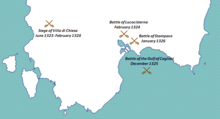
Back Conquesta aragonesa de Sardenya Catalan Conquista aragonesa de Cerdeña Spanish Conquête de la Sardaigne par les Aragonais French Conquista aragonese della Sardegna Italian Арагонское завоевание Сардинии Russian
| Conquest of Sardinia | |||||||
|---|---|---|---|---|---|---|---|
 Major battles of the campaign | |||||||
| |||||||
| Belligerents | |||||||
|
| |||||||
| Commanders and leaders | |||||||
|
|
| ||||||
| Strength | |||||||
| Unknown | Unknown | ||||||

Red, Republic of Pisa
Yellow, Doria
Black, Comune of Sassari
Green, della Gherardesca gherardiani
Purple, Malaspina
Blue, Judicate of Arborea
The Aragonese conquest of Sardinia took place between 1323 and 1326. The island of Sardinia was at the time subject to the influence of the Republic of Pisa, the Pisan della Gherardesca family, Genoa and of the Genoese families of Doria and the Malaspina; the only native political entity survived was the Judicate of Arborea, allied with the Crown of Aragon. The financial difficulties due to the wars in Sicily (until 1295), the conflict with the Crown of Castile in the land of Murcia and Alicante (1296–1304) and the failed attempt to conquer Almeria (1309) explain the delay of James II of Aragon in bringing the conquest of Sardinia, enfeoffed to him by Pope Boniface VIII in 1297.
The possession of the island of Sardinia was crucial for the Crown of Aragon. Sardinia was abundant of natural resources like silver and salt and had a thriving agro-pastoral economy; also its geographical location ensured more control over the western Mediterranean and the island itself was an indispensable basis for the creation of so-called ruta de las islas (route of the islands) that allowed to halve the time of sailing to reach the rich markets of the Eastern Mediterranean.